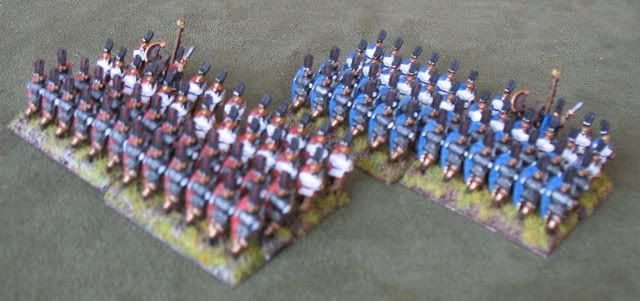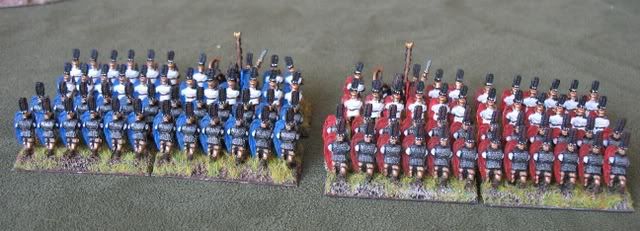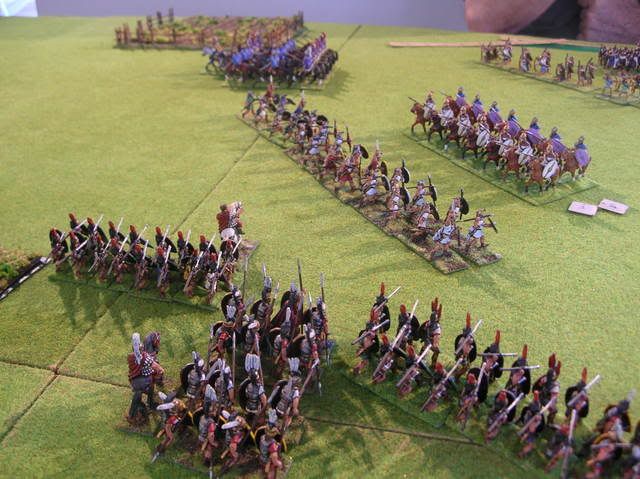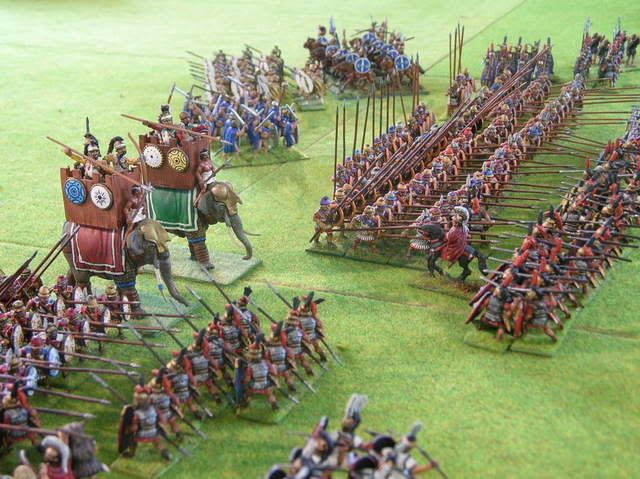Mid-Republican Roman Question
Moderators: hammy, philqw78, terrys, Slitherine Core, Field of Glory Design, Field of Glory Moderators
Mid-Republican Roman Question
What percentage of Hastati/Principes minis should have on chainmail vs breast plate?
-
Jason_Langlois
- Corporal - Strongpoint

- Posts: 56
- Joined: Mon Apr 28, 2008 3:50 am
-
WhiteKnight
- Sergeant First Class - Panzer IIIL

- Posts: 354
- Joined: Fri Mar 21, 2008 7:08 pm
- Location: yeovil somerset
IMO, the Roman armies of the Republic would not present a uniform appearance and each would come eqipped in what he could afford for protection. The poorest citizens might have no body armour at all above a simple helmet, some would have bronze pectoral plates and variations of it, others steel mail shirts. Some would sport a pair of bronze greaves, others only have one on the leading leg, others still nothing or improvised leather greaves. Since older men on average served in the principes, the chances of them having more protection due to their wealth is greater, whereas the hastati were younger men so were likely less well armoured.
So in a BG of hastati/principes, I would use a mixture of figures in various armour and use them as protected/armoured as appropriate. I expect that more heavily armoured men of each type made up the front ranks with less well protected men standing further back?
Martin
So in a BG of hastati/principes, I would use a mixture of figures in various armour and use them as protected/armoured as appropriate. I expect that more heavily armoured men of each type made up the front ranks with less well protected men standing further back?
Martin
-
Strategos69
- Lieutenant Colonel - Elite Panther D

- Posts: 1375
- Joined: Mon May 19, 2008 10:53 pm
- Location: Alcalá de Henares, Spain
I agree with what it has been said before. Usually people try to depict Romans as if they were a regular army. Weapons were sometimes inherited from father to son and they were decorated (especially the scuta, as you can see in the image). So a correct representation of the Roman army at that time should have their shields painted in different colurs and with different images painted on them. It is also probable that, after heavy losses in the war against Hannibal, equipement was produced in mass to equip the new legions. That time standards of wealth were reduced to incorporate more soldiers when Hannibal destroyed all the Roman armies that faced him.
 Regarding your question, Polybius (bo ... d legions?
Regarding your question, Polybius (bo ... d legions?
 Regarding your question, Polybius (bo ... d legions?
Regarding your question, Polybius (bo ... d legions?-
Seldon
- Administrative Corporal - SdKfz 251/1

- Posts: 145
- Joined: Mon Mar 03, 2008 11:25 pm
- Location: Austin, TX
I would mostly agree with Mr Strategos interpretation. It seems reasonable that Hastati would be less armored than Princeps due to having less resources.
Now regarding the alleged mistake in FOG I would dispute that due to the following:
1) The authors mention that BGs can be combinations of different units so you could build a BG formed of a first line of Hastati and a second line of princeps. When I do this I tend to assume that the overall BG is armoured since probably all princeps would have chain mail, some of the hastati might, they would mostly have the left greave plus with the pectoral plate of the other hastati and the large shield you can live with armored.
2) Since the rules allow for both protected and armored you can choose to build one group armored and one group protected thus a legion woudl have one BG princeps armored, one BG hastati protected and then the triarii
So in the end FOG does not present a statement and simply allows the flexibility to represent the army in both alternative ways, including the one that Strategos presents which I happend to agree with.
Option 1)
In 10mm I tend to represent the BG as 4 lines two of hastati and two of princeps


Option 2 )
This is the way we represent option number 2 when we play 25mm. On the right armored princeps, on the left protected hastati and in the middle triarii

Hastati on the left ( all protected )

Princeps further to the right ( all armored )

And between them you could see the triarii, armored and with long spear
Of course these are all just suggestions...
cheers
Francisco
Now regarding the alleged mistake in FOG I would dispute that due to the following:
1) The authors mention that BGs can be combinations of different units so you could build a BG formed of a first line of Hastati and a second line of princeps. When I do this I tend to assume that the overall BG is armoured since probably all princeps would have chain mail, some of the hastati might, they would mostly have the left greave plus with the pectoral plate of the other hastati and the large shield you can live with armored.
2) Since the rules allow for both protected and armored you can choose to build one group armored and one group protected thus a legion woudl have one BG princeps armored, one BG hastati protected and then the triarii
So in the end FOG does not present a statement and simply allows the flexibility to represent the army in both alternative ways, including the one that Strategos presents which I happend to agree with.
Option 1)
In 10mm I tend to represent the BG as 4 lines two of hastati and two of princeps


Option 2 )
This is the way we represent option number 2 when we play 25mm. On the right armored princeps, on the left protected hastati and in the middle triarii

Hastati on the left ( all protected )

Princeps further to the right ( all armored )

And between them you could see the triarii, armored and with long spear
Of course these are all just suggestions...
cheers
Francisco
-
Strategos69
- Lieutenant Colonel - Elite Panther D

- Posts: 1375
- Joined: Mon May 19, 2008 10:53 pm
- Location: Alcalá de Henares, Spain
I think that Seldon's advice is a good one. I didn't mean to critize FoG as I know how difficult is to design a game for such a vaste period of time. In fact, most of the problems come from the intention to cover 3.000 years. What I meant was that "there is life beyond FoG" and I think that the way you base your miniatures should be appropriate for other more speciffic game systems in which hastati are separated from principes.
After having read Polybius, I have come to the conclusion that a four armour class system (three in Ancients as heavy armour is just for cataphracts) cannot depict many situations described in it. For example, in Telamon naked gaesati are told to suffer from velites javelins more than other Gauls because of the lack of protection but both are protected in FoG. Should they be unprotected? I do not think so. In fact, with hastati and principes it happens the same thing. I like the idea of Seldon of two battle groups, one in front protected and a second one armoured, but in game terms they are not intended to be deployed one after another and there are not rules that allow voluntary retreats and interpenetrations of heavy foot. Simply the scope of the game cannot depict that.
If I were told to vote, I will recommend you Seldon's option 1 as it allows you to play other game systems and it is very accurate. you may add some chain mail miniatures in the first line if you want some variations. Eyy, Seldon, very good minis, for instance.
Un saludo
Óliver
After having read Polybius, I have come to the conclusion that a four armour class system (three in Ancients as heavy armour is just for cataphracts) cannot depict many situations described in it. For example, in Telamon naked gaesati are told to suffer from velites javelins more than other Gauls because of the lack of protection but both are protected in FoG. Should they be unprotected? I do not think so. In fact, with hastati and principes it happens the same thing. I like the idea of Seldon of two battle groups, one in front protected and a second one armoured, but in game terms they are not intended to be deployed one after another and there are not rules that allow voluntary retreats and interpenetrations of heavy foot. Simply the scope of the game cannot depict that.
If I were told to vote, I will recommend you Seldon's option 1 as it allows you to play other game systems and it is very accurate. you may add some chain mail miniatures in the first line if you want some variations. Eyy, Seldon, very good minis, for instance.
Un saludo
Óliver
I am afraid that I will have to respectfully disagree with a few aspects of this interpretation of Polybius. Here is the text of Histories 6.23, as translated by W. R. Paton for the Loeb Classical Library:Strategos69 wrote:Regarding your question, Polybius (book VI, read it!) describes that hastati were formed with citizens with less resources and young citizens (that may have one chain mail). They were told to wear feather in their helmets, but not triarii nor principes. Anyway, I would follow the advice given by White Knight but with some precautions:
1) Some hastati may have some bronze pectoral plates and some chain mail.
2) Principes had just chain mail.
The complete text may be found here: http://penelope.uchicago.edu/Thayer/E/R ... Polybius/6*The next in seniority called hastati are ordered to wear a complete panoply. The Roman panoply consists firstly of a shield (scutum), the convex surface of which measures two and a half feet in width and four feet in length, the thickness at the rim being a palm's breadth. It is made of two planks glued together, the outer surface being then covered first with canvas and then with calf-skin. Its upper and lower rims are strengthened by an iron edging which protects it from descending blows and from injury when rested on the ground. It also has an iron boss (umbo) fixed to it which turns aside the most formidable blows of stones, pikes, and heavy missiles in general. Besides the shield they also carry a sword, hanging on the right thigh and called a Spanish sword. This is excellent for thrusting, and both of its edges cut effectually, as the blade is very strong and firm. In addition they have two pila, a brass helmet, and greaves.
The pila are of two sorts — stout and fine. Of the stout ones some are round and a palm's length in diameter and others are a palm square. Fine pila, which they carry in addition to the stout ones, are like moderate-sized hunting-spears, the length of the haft in all cases being about three cubits. Each is fitted with a barbed iron head of the same length as the haft. This they attach so securely to the haft, carrying the attachment halfway up the latter and fixing it with numerous rivets, that in action the iron will break sooner than become detached, although its thickness at the bottom where it comes in contact with the wood is a finger's breadth and a half; such great care do they take about attaching it firmly.
Finally they wear as an ornament a circle of feathers with three upright purple or black feathers about a cubit in height, the addition of which on the head surmounting their other arms is to make every man look twice his real height, and to give him a fine appearance, such as will strike terror into the enemy. The common soldiers wear in addition a breastplate of brass a span square, which they place in front of the heart and call the heart-protector (pectorale), this completing their accoutrements; but those who are rated above ten thousand drachmas wear instead of this a coat of chain-mail (lorica). The principes and triarii are armed in the same manner except that instead of the pila the triarii carry long spears (hastae).
According to the final sentence quoted above, Polybius is saying that the hastati, principes and triarii were all "armed in the same manner" with the complete legionary panoply, the sole exception being that the triarii carried hastae rather than pila. So all three groups would have worn helmets decorated with the distinctive circle of three feathers, and all three groups would have included some soldiers wearing bronze pectorals, and others (those rated above 10,000 drachmae) in mail loricae. OTOH, it can be surmised that the principes and triarii, being comprised of older and more experienced men, would likely have fielded a higher proportion wearing loricae.
Cheers,
Scott
-
Strategos69
- Lieutenant Colonel - Elite Panther D

- Posts: 1375
- Joined: Mon May 19, 2008 10:53 pm
- Location: Alcalá de Henares, Spain
Thanks, I haven't seen the sentence that way when I first read it. It is a very interesting discussion and it depends on how you interpret "principes and triarii are armed in the same manner". I thought that "same" just referred to the latter mentioned, "chain-mail", but it is true that you could have the other interpretation as well. Maybe a classical Greek translator would be able to clarify the sentence.ars_belli wrote: The common soldiers wear in addition a breastplate of brass a span square, which they place in front of the heart and call the heart-protector (pectorale), this completing their accoutrements; but those who are rated above ten thousand drachmas wear instead of this a coat of chain-mail (lorica). The principes and triarii are armed in the same manner except that instead of the pila the triarii carry long spears (hastae).
Anyway I think that, as classification of hastati, principes and triarii was based both in age and wealth as it is stated in Polybius (VI, 21), it is more accurate to depict them just in chain mail armour:
(Underlining is mine.) Therefore, principes being reacher, I also assume they wore chain mail (lorica hamata), but it is true that it is not possible to state that not a single princeps did not wear a breastplate only.Polybius wrote:6 The tribunes in Rome, after administering the oath, fix for each legion a day and place at which the men are to present themselves without arms and then dismiss them. 7 When they come to the rendezvous, they choose the youngest and poorest to form the velites; the next to them are made hastati; those in the prime of life principes; and the oldest of all triarii, 8 these being the names among the Romans of the four classes in each legion distinct in age and equipment. 9 They divide them so that the senior men known as triarii number six hundred, the principes twelve hundred, the hastati twelve hundred, the rest, consisting of the youngest, being velites. If the legion consists of more than four thousand men, they divide accordingly, except as regards the triarii, the number of whom is always the same.
Un saludo
Óliver
-
Quintus
- Administrative Corporal - SdKfz 232 8Rad

- Posts: 152
- Joined: Wed Feb 20, 2008 7:34 pm
- Location: Welsh Marches
As someone who has reached the stage of being numbered among the triarii, I question the common supposition that the older soldiers were more likely to be able to afford better gear (i.e. a mail shirt).
With the years come responsibilities and expense (wife and children) and if my experience is anything to go by, older family men tend to be skint.
That's life!
With the years come responsibilities and expense (wife and children) and if my experience is anything to go by, older family men tend to be skint.
That's life!









